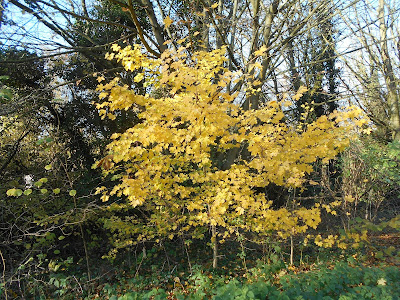I also set forth today, with no particular objective in mind other than a vague idea of making myself familiar with as-yet unknown areas of Daventry; for a small town it has lots of little surprises.
About three months ago I discovered a Foxglove Tree, Paulownia tomentosa, in the heart of Daventry. Its huge leaves have now fallen but this has exposed the curious fruits. The flower buds are already present but will remain dormant through the coldest months, to open in the spring - providing they have not been killed off by a harsh winter.
 |
Brilliant blue sky, but it was very cold. The fruits of a Foxglove Tree
stand out clearly. Daventry, 28 November, 2017
|
My walk, in bitingly cold conditions, took me into the Southbrook area, passing tangles of Traveller's Joy, Clematis vitalba, on the way. This member of the Buttercup Family, Ranunculaceae, may appear quite different from our idea of buttercups until one remembers the similar feathery styles of the related Pasque Flower, Pulsatilla vulgaris.
 |
The tangled silky styles of Traveller's Joy scrambled through shrubs.
Daventry, 28 November, 2017
|
Bearing in mind my comments about bees in the opening paragraph I kept an eye open for nectar or pollen sources but, other than Laurustinus and various forms of Mahonia there was little to be seen. There was one plant producing pollen in plenty but of no interest to bees. I refer to the Common Nettle, Urtica dioica, surprisingly still in flower. The flowers are either male or female, usually on separate plants, i.e. dioecious, and the male plants produce wind-blown pollen of no interest to bees.
 |
Common Nettle in flower, Southbrook, Daventry.
28 November, 2017
|
The foliage is highly nutritious, attracting numerous phytophagous insects, including the caterpillars of Peacock, Red Admiral and Small Tortoiseshell butterflies, during the warmer months. Many books have been written on the subject and some horticultural writers encourage people to spare an odd corner of the garden for a clump of nettles but the general abundance of the plant renders this quite unnecessary.
Finally, an apology. I had intended to publish this blog 24 hours earlier but, overcome with joy at the news of the royal engagement, I had to wait until the trembling in my fingers had subsided. (Oddly enough, just 21 minutes after the news broke of the engagement, the government announced that benefits would be frozen for the next 12 months. Now there's a coincidence.)
 |
| 'Insects on Nettles' by B.N.K. Davis, a useful introduction to the invertebrate fauna of nettles. |
There may have been a general lack of flowers but there was plenty of colour, not least from the Acers in gardens and at the wayside. This Field Maple, Acer campestre, with primrose-yellow foliage, was quite arresting. It is our only certain native maple (Sycamore, Acer pseudoplatanus is probably alien) and I am told that it can be distinguished from exotic maples by a milky exudation from a damaged leaf, but I have never observed this. The wood is exceptionally hard and is used for veneers and fine wood-turning. Apparently harps are also constructed from this material and it was used in mediaeval times for carved drinking bowls called 'mazers'.
 |
Field Maple, lovely in its late autumn foliage. Southbrook, Daventry.
28 November, 2017
|
A quite different foliage is to be seen on Magnolia grandiflora and I mention this because today I saw a particularly fine specimen of this tree from the southern U.S.A. completely filling a garden along Norton Road.
 |
A fine example of Magnolia grandiflora, aka Evergreen Magnolia or
Bull Bay. Southbrook, Daventry. 28 November, 2017
|
The leathery evergreen leaves have a glossy upper surface and an orange, rather downy lower surface. I suppose there would be a deep shade cast upon the house in question but I for one would be loth to remove this handsome tree.
 |
| The underside of the leaves are a rusty orange. |
I have had more exciting days but I arrived back in Daventry's town centre well satisfied with my morning's jaunt, feeling that I had earned a hot chocolate in a local café.













































